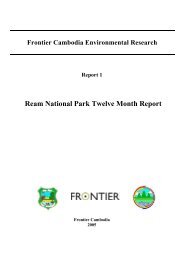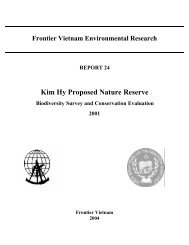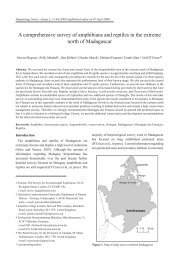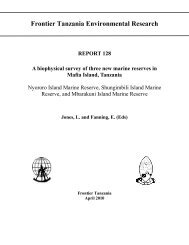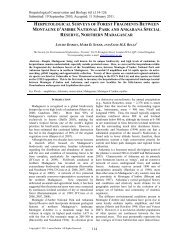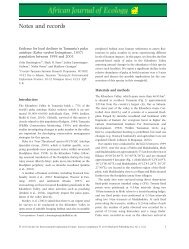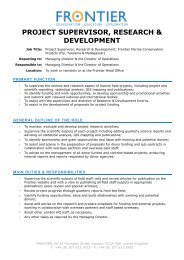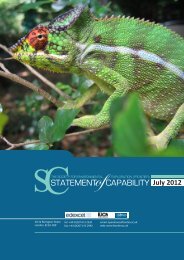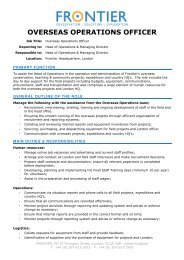An assessment of local fisheries in Diego-Suarez Bay, Madagascar
An assessment of local fisheries in Diego-Suarez Bay, Madagascar
An assessment of local fisheries in Diego-Suarez Bay, Madagascar
Create successful ePaper yourself
Turn your PDF publications into a flip-book with our unique Google optimized e-Paper software.
ut the majority <strong>of</strong> fishermen do not have a specific day, fish<strong>in</strong>g on any day <strong>of</strong> the week (44%). The<br />
number <strong>of</strong> hours spent fish<strong>in</strong>g ranged from one to twelve hours per day, with a mean <strong>of</strong> five hours.<br />
The months around the turn <strong>of</strong> the year (November, December, January and February) were the most<br />
favourable months <strong>in</strong> which to fish with December be<strong>in</strong>g the most popular (11%).<br />
The most common types <strong>of</strong> fish<strong>in</strong>g gear used were the fish<strong>in</strong>g net and a hook and l<strong>in</strong>e (figure 5). There<br />
was a significant difference <strong>in</strong> the types <strong>of</strong> gear used by fishermen <strong>in</strong> Ramena and those <strong>in</strong>terviewed from<br />
<strong>An</strong>tsisikala. Chi-square cont<strong>in</strong>gency tests us<strong>in</strong>g the total frequency counts for each fishermen us<strong>in</strong>g each<br />
gear from Ramena or from <strong>An</strong>tsisikala showed there is an association between gear use and where the<br />
fishermen came from. (χ 2 = 14.97, df = 5, p < 0.010). Se<strong>in</strong>e nett<strong>in</strong>g was used by 56% <strong>of</strong> the fishermen <strong>in</strong><br />
Ramena, compared to none <strong>of</strong> fishermen from <strong>An</strong>tsisikala. Accord<strong>in</strong>g to 92% <strong>of</strong> fishermen, fish<strong>in</strong>g<br />
techniques had not changed <strong>in</strong> the years that they had been fish<strong>in</strong>g.<br />
Percentage <strong>of</strong> fishermen<br />
100<br />
90<br />
80<br />
70<br />
60<br />
50<br />
40<br />
30<br />
20<br />
10<br />
0<br />
yes when fish<br />
too small<br />
yes when fish<br />
is non-target<br />
yes when its<br />
not a valuable<br />
species<br />
not good to<br />
eat<br />
Reason for throw<strong>in</strong>g fish back<br />
Figure 6. Reason for throw<strong>in</strong>g fish back (n=36)<br />
do not throw<br />
anyth<strong>in</strong>g back<br />
Seventy-two percent <strong>of</strong> the fishermen would throw fish back while 28% would not. Of the 72% that said<br />
yes, 67% <strong>of</strong> fishermen throw fish back if they are too small, 31% if they are non-target species, 14% if<br />
they not valuable and 0% throw fish back if they are not good to eat.<br />
The majority <strong>of</strong> fishermen reported a mean daily catch weight between 1-25kg (77%). With<strong>in</strong> this size<br />
class the weights varied from 2kg to 25kg. Weight classes 25-49kg and 50-75kg had a lower frequency<br />
(both 10%). However, there was a significantly higher frequency <strong>of</strong> catches from the weight classes 25-<br />
49kg and 50-75kg by fishermen from Ramena, than from <strong>An</strong>tsisikala (χ 2 = 8.53, df = 3, p < 0.036).<br />
8



